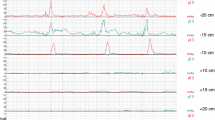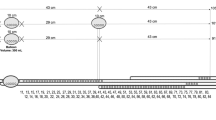Abstract
Radiologic, endoscopic and histomorphologic studies have suggested the presence of a sphincter at the cecocolonic junction (CCJ), while some investigators have denied its existence. To investigate the physiologic activity at the CCJ, the right colon was exposed during right hemicolectomy for early colonic cancer in 11 patients (mean age 43.6±12.3 years; 8 men). Three manometric catheters were introduced through colotomy to be separately located in the cecum, CCJ and ascending colon. We determined the CCJ pressure response to cecal and colonic distension by means of a balloon filled with saline in increments of 10 ml. The test was repeated after individual anesthetization of cecum, CCJ and ascending colon. The CCJ measured 1.6±0.6 cm in length and had a higher pressure (p<0.05) than the cecum or colon. Large-volume cecal distension effected a significant CCJ pressure reduction which was augmented as the distension increased. Latency decreased upon increase of the distending volume. In contrast, the CCJ responded to large-volume colonic distension by pressure elevation which increased upon increase of the distending volume. Latency diminished with increased distension. Small-volume cecal or colonic distension effected no CCJ pressure response. The anesthetized CCJ did not respond to distension of the cecum or colon. Likewise, the CCJ did not exhibit a pressure response to distension of the anesthetized cecum or colon. The CCJ is a high-pressure zone which reacts to cecal or colonic distension by dilatation or narrowing, respectively. These data presumably denote the existence of a physiologic sphincter at the CCJ. We suggest that the CCJ pressure response to cecal or colonic distension is reflex and mediated through the cecocolonic inhibitory and colocecal excitatory reflexes, respectively. The role of the CCJ and related reflexes in colonic motility disorders needs to be studied. The French version of this article is available in the form of electronic supplementary material and can be obtained by using the Springer Link server located at http://dx.doi.org/10.1007/s00276-002-0089-3.
Résumé
Des études radiologiques, endoscopiques et histo-morphologiques ont suggéré la présence d'un sphincter à la jonction caeco-colique (CCJ) alors que d'autres chercheurs ont nié son existence. Pour étudier l'activité physiologique de la CCJ, le colon droit a été exposé au cours d'hémicolectomies droites réalisées pour des cancers coliques débutants chez 11 patients (âge moyen 43,6 ± 12,3 ans; 8 hommes, 3 femmes). Trois cathéters de manométrie ont été introduits par une colotomie et ont été mis en place séparément dans le caecum, la CCJ et le côlon ascendant. La réponse en pression de la CCJ à une distension caecale et colique a été déterminée au moyen d'un ballon rempli de sérum salé par paliers de 10 ml. Le test a été répété après anesthésie individuelle du caecum, de la CCJ et du côlon ascendant. La CCJ mesurait 1,6 cm ± 0,6 de long et avait une pression plus élevée (p<0,05) que le caecum ou le côlon. La distension caecale par un grand volume entraînait une diminution de pression significative de la CCJ, qui s'aggravait au fur et à mesure que la distension augmentait. La latence diminuait avec l'augmentation du volume de distension. A l'inverse, la CCJ répondait à une distension colique par un grand volume sous forme d'une élévation de pression qui augmentait parallèlement à l'augmentation du volume de distension. La latence diminuait avec l'augmentation de la distension. La distension caecale ou colique de petit volume n'entraînait aucune modification de la pression de la CCJ. La CCJ anesthésiée ne répondait pas à la distension du caecum ou du côlon. De même, la CCJ ne montrait pas de réponse en pression à la distension du caecum ou du côlon anesthésié. La CCJ est une zone de haute pression qui réagit à la distension caecale ou colique, respectivement par une dilatation ou un rétrécissement. Ces données suggèrent l'existence d'un sphincter physiologique à la CCJ. Nous pensons que la réponse en pression de la CCJ à une distension colique ou caecale est réflexe et qu'elle est assurée par des réflexes inhibiteur caeco-colique et excitateur colo-caecal. Le rôle de la CCJ et les troubles reflexes de la mobilité colique qui y sont liés nécessitent des études ultérieures.





Similar content being viewed by others
References
Cotton PB, Williams CB (1990) Practical gastrointestinal endoscopy. Blackwell, Oxford, pp 209–211
DiDio LJA, Geocze S, Ferrari AP (1994) Endoscopic study of the ileal papilla in a normal case and in patients under pathologic conditions. Ann Anat 176: 263–268
Faussone-Pellegrini MS, Pantalone D, Cortesini C (1993) Morphological evidence for a cecocolonic junction in man and functional implications. Acta Anat 146: 22–30
Faussone-Pellegrini MS, Bacci S, Pantalone D, Cortesini C, Mayer B (1994) Nitric oxide synthase immunoreactivity in the human ileocecal region. Neurosci Lett 170: 261–265
Faussone-Pellegrini MS, Ibba V, Manneschi L (1995) The cecocolonic junction in humans has a sphincteric anatomy and function. Gut 37: 493–498
Fit I (1956) The structure and development of the ileocecal valve and its frenula. Indian J Med Res 44: 361–373
Grilli A (1968) Compendio di radiologia medica. SEU, Rome, pp 821–830
Hickel L, Bernard JM (1963) Anatomo-physiologie radiologique du gros intestin normal. Semaines Hôpitalières 39:139–150
Pelckmans PA (1988) Study in the sphincteric nature of the ileocecal junction: a morphological and pharmacological approach (thesis). University of Antwerp
Quigley FM, Phillips SF (1983) The ileocecal (ileocolonic) sphincter. Z Gastroenterol 21: 47–55
Schiller KFR, Cockel R, Hunt RH (1986) A color atlas of gastrointestinal endoscopy. Chapman, London, pp 181–182
Torsoli A, Ramorino ML, Crocioli V (1968) The relationships between anatomy and motor activity of the colon. Am J Dig Dis 13: 462–467
Acknowledgement
Margot Yehia assisted in preparing the manuscript.
Author information
Authors and Affiliations
Corresponding author
Additional information
The French version of this article is available in the form of electronic supplementary material and can be obtained by using the Springer Link server located at http://dx.doi.org/10.1007/s00276-002-0089-3
Rights and permissions
About this article
Cite this article
Shafik, A., Mostafa, R.M., Shafik, A.A. et al. Study of the functional activity of the cecocolonic junction with identification of a "physiologic sphincter", "cecocolonic inhibitory reflex" and "colocecal excitatory reflex". Surg Radiol Anat 25, 16–20 (2003). https://doi.org/10.1007/s00276-002-0089-3
Received:
Accepted:
Published:
Issue Date:
DOI: https://doi.org/10.1007/s00276-002-0089-3




